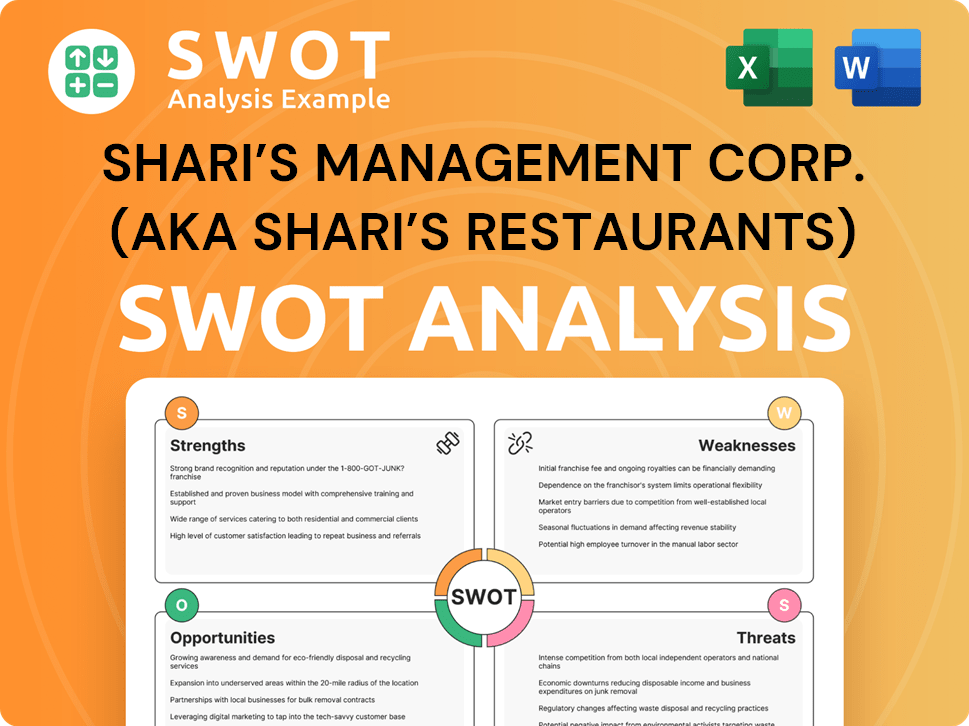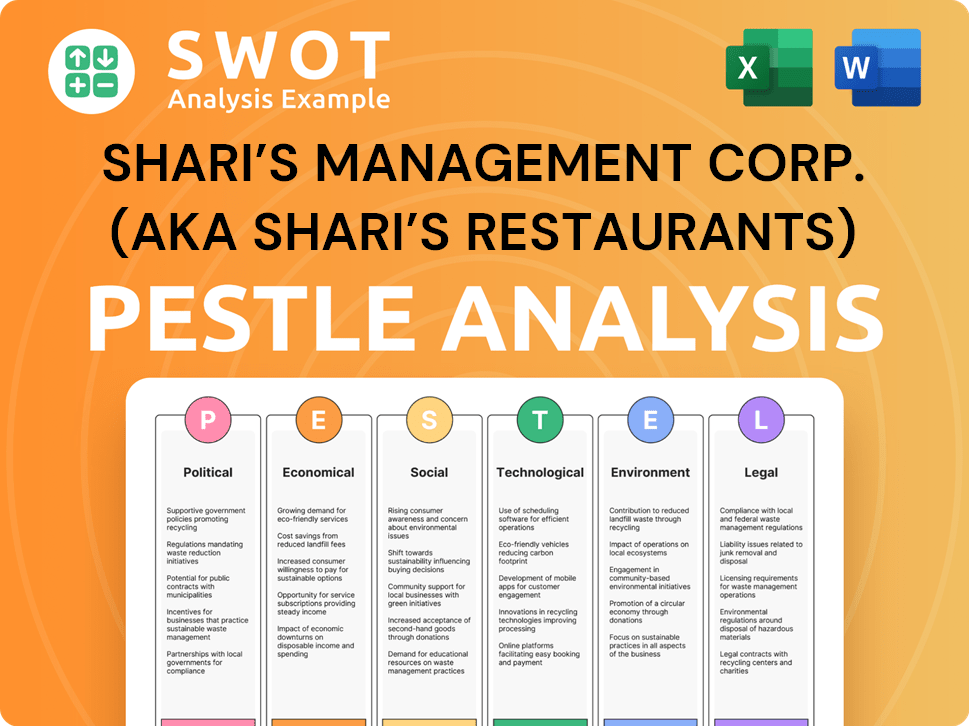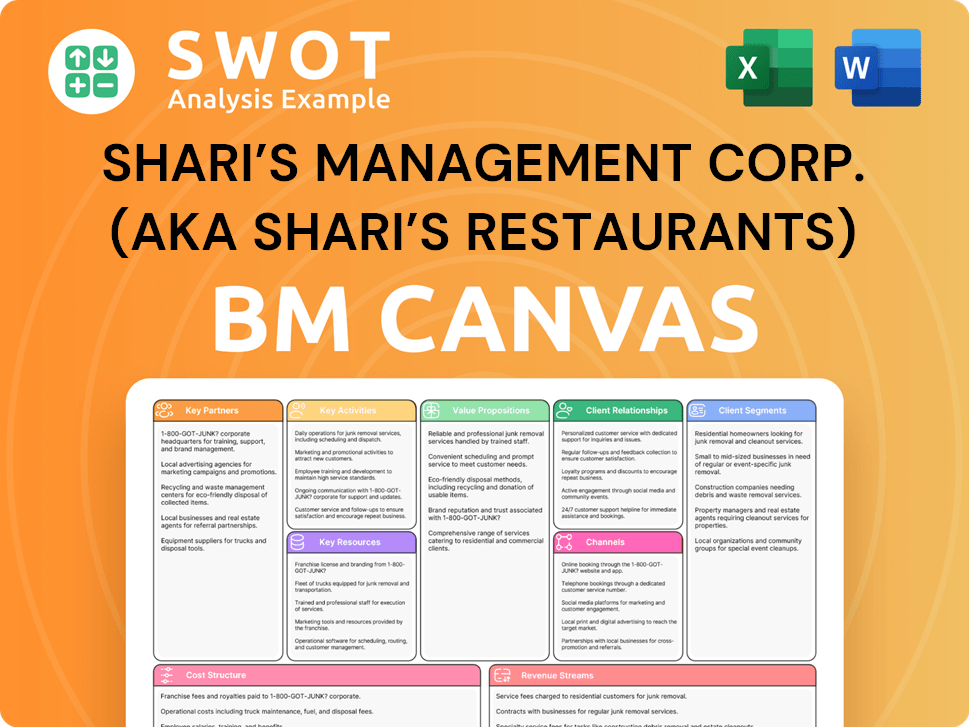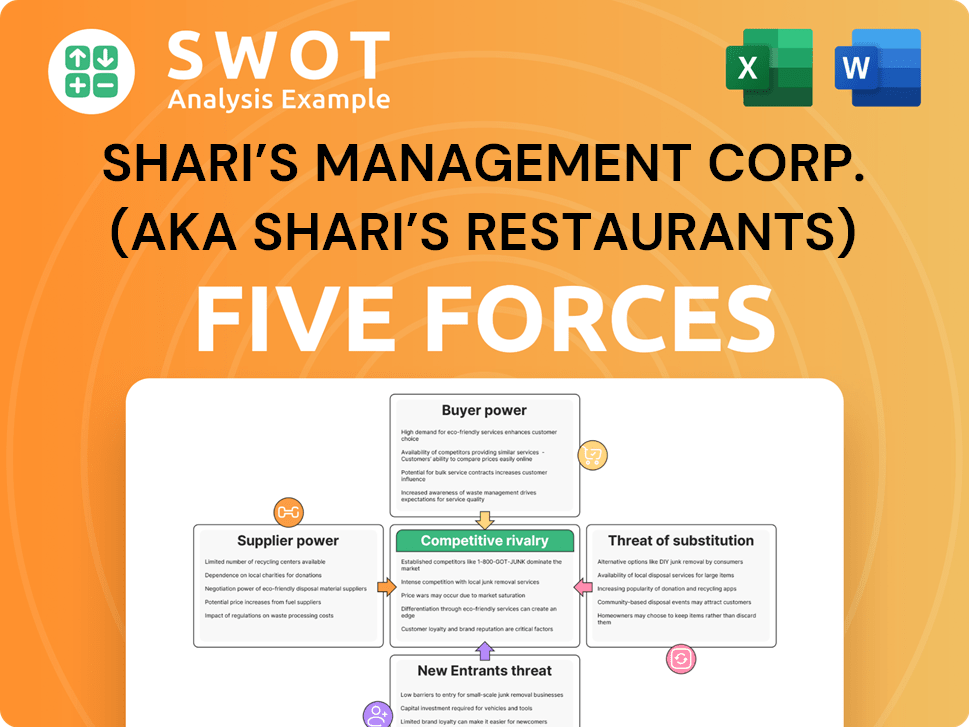Shari’s Management Corp. (aka Shari’s Restaurants) Bundle
Can Shari's Restaurants Reclaim Its Slice of the Market?
The family dining sector is in flux, and Shari’s Management Corp. (aka Shari’s Restaurants) SWOT Analysis is at the heart of this transformation. Founded in 1978, Shari's Restaurants, known for its comforting atmosphere and iconic pies, once dominated the Pacific Northwest. But, with the closure of numerous locations, the company's future hangs in the balance, prompting a critical examination of its competitive standing.

This deep dive into the Shari's Restaurants competitive landscape will dissect its market position, pinpointing its key competitors and evaluating its competitive advantages. We'll explore the challenges and opportunities shaping Shari's Restaurants, including industry trends and financial performance. Understanding the restaurant industry competition is crucial to assess Shari's Restaurants' ability to navigate this dynamic environment and chart a course for future success, comparing it to rivals like Denny's and IHOP.
Where Does Shari’s Management Corp. (aka Shari’s Restaurants)’ Stand in the Current Market?
Shari's Management Corp. operates as a chain of family dining restaurants, primarily in the United States, with a historical focus on the Pacific Northwest. The company's core operations center around providing a diverse menu of breakfast, lunch, and dinner options, along with pies and desserts. Their value proposition has been built on offering a comfortable, welcoming, family-style dining experience, catering to a broad customer segment seeking comfort food in a casual atmosphere.
The company's market position has significantly shifted due to financial challenges and closures. While specific market share figures for Shari's in 2024-2025 are not publicly available, the company's geographic presence has been reduced. The company has faced substantial closures, including all locations in Oregon by October 2024, and nearly a dozen closures in Idaho and Washington in the last six months of 2024. This indicates a contraction in its market penetration.
Historically, Shari's has aimed to serve a broad customer segment seeking comfort food and a casual atmosphere. However, recent financial struggles, including reliance on video lottery gaming revenue in Oregon and significant lottery debts, have contributed to widespread closures. The overall financial health of Shari's appears strained compared to industry averages, with reports of unpaid bills, back taxes, and evictions. For more insights, you can explore the Growth Strategy of Shari’s Management Corp. (aka Shari’s Restaurants).
Shari's Restaurants' market share in 2024 has decreased due to widespread closures. The company has experienced a reduction in its geographic footprint, particularly in the Pacific Northwest. These closures have directly impacted its ability to compete effectively within the restaurant industry competition.
The financial performance of Shari's Restaurants has been under pressure. Reports indicate unpaid bills, back taxes, and evictions, signaling financial strain. These challenges have made it difficult for Shari's to maintain its competitive position and compete with other restaurants.
Shari's Restaurants faces intense competition from various players in the casual dining market. The company competes with both national chains and regional competitors. Understanding the competitive advantages of Shari's Restaurants is crucial in this environment.
Shari's Restaurants faces several challenges, including financial difficulties and reduced market presence. However, there might be growth opportunities through strategic initiatives. Analyzing industry trends and the company's business model is essential for future success.
Several factors influence Shari's Restaurants' competitive landscape, including its financial performance, market share, and ability to adapt to industry trends. The company's ability to maintain its market position will depend on its competitive strategy and how it addresses the challenges it faces.
- Financial Health: The company's financial stability is critical.
- Market Presence: Maintaining a strong geographic presence is essential.
- Competitive Strategy: Adapting to the competitive environment.
- Customer Experience: Providing a positive dining experience.
Shari’s Management Corp. (aka Shari’s Restaurants) SWOT Analysis
- Complete SWOT Breakdown
- Fully Customizable
- Editable in Excel & Word
- Professional Formatting
- Investor-Ready Format

Who Are the Main Competitors Challenging Shari’s Management Corp. (aka Shari’s Restaurants)?
The competitive landscape of Shari’s Management Corp. (aka Shari’s Restaurants) is shaped by its position within the family dining and casual restaurant sectors. Understanding the key competitors is crucial for a comprehensive Shari's Management Corp. analysis, as it directly impacts market share and strategic decisions. The restaurant industry competition is intense, with various players vying for consumer spending.
Shari's Restaurants' market position is influenced by the performance of its competitors. These competitors range from large, established chains to emerging fast-casual and quick-service restaurants (QSRs). The dynamics of the restaurant industry competition, including shifting consumer preferences and economic conditions, constantly reshape the competitive environment. This necessitates continuous competitive analysis for Shari's Restaurants.
Shari's Restaurants faces a diverse set of competitors, each with its own strengths and strategies. Identifying these rivals is essential for understanding the challenges and opportunities within the market. The competitive advantages of Shari's Restaurants are directly influenced by how it differentiates itself from these key players.
Direct competitors of Shari's Restaurants include established family dining chains and similar casual dining establishments. These competitors often compete on menu offerings, pricing, and customer experience. They target a similar demographic and compete for the same customer base.
Indirect competitors include quick-service restaurants (QSRs) and fast-casual dining options that offer speed and convenience. These competitors attract customers looking for quicker meal options. They also include grocery stores and food delivery services.
According to PitchBook, key direct competitors include Del Taco, Ascent Hospitality Management, Cracker Barrel Old Country Store, Brinker International, and Jims Restaurants. Tracxn also identifies Burger King, First Watch, and Bob Evans Farms as top competitors. These companies present the most direct challenges to Shari's Restaurants.
Larger chains such as Cracker Barrel Old Country Store and Brinker International often have greater economies of scale, extensive marketing budgets, and broader geographic reach. Fast-casual and QSRs like Del Taco benefit from speed and convenience. Understanding these advantages helps Shari's develop its competitive strategy.
The family dining segment is affected by shifts towards quick-service and fast-casual options, as well as the growing preference for off-premise dining. Industry trends, such as the rise of delivery services, also influence the competitive landscape. Adapting to these trends is crucial for Shari's Restaurants.
The casual dining industry has seen significant shifts, with some chains performing strongly while others face closures and financial difficulties. The impact of mergers and alliances, such as Shari's acquisition of Coco's and Carrows in 2018, can reshape competitive dynamics. These dynamics influence Shari's Restaurants' strategic decisions.
A comprehensive competitive analysis for Shari's Restaurants must consider various factors to assess its market position. It's important to understand how Shari's Restaurants compares to competitors like Denny's and IHOP. Furthermore, a SWOT analysis can reveal internal strengths and weaknesses, as well as external opportunities and threats.
- Market Share: Analyzing market share data to understand Shari's position relative to competitors.
- Financial Performance: Comparing financial metrics such as revenue, profit margins, and sales growth.
- Customer Preferences: Understanding consumer choices and how they influence dining decisions.
- Operational Efficiency: Assessing factors like supply chain management and labor costs.
- Innovation: Evaluating menu development, technology adoption, and marketing strategies.
Shari’s Management Corp. (aka Shari’s Restaurants) PESTLE Analysis
- Covers All 6 PESTLE Categories
- No Research Needed – Save Hours of Work
- Built by Experts, Trusted by Consultants
- Instant Download, Ready to Use
- 100% Editable, Fully Customizable

What Gives Shari’s Management Corp. (aka Shari’s Restaurants) a Competitive Edge Over Its Rivals?
Historically, the competitive advantages of Shari's Restaurants, also known as Shari's Management Corp., stemmed from its established brand recognition in the Pacific Northwest, offering a family-friendly dining experience. Their signature pies and a menu centered on fresh Northwest comfort food were designed to be distinguishing features. Furthermore, the company had a revenue stream from video lottery gaming in its Oregon locations.
However, recent developments suggest these advantages have eroded. The widespread closures of locations in late 2024 across Oregon, Washington, and Idaho indicate a significant decline in market presence and customer loyalty. While Shari's offered competitive employee benefits, these were insufficient to overcome broader operational and financial challenges. The company's ability to leverage economies of scale has likely diminished due to the reduced number of operating units.
The reliance on video lottery revenue proved to be a vulnerability, especially when financial difficulties arose, leading to lottery debts. Efforts like the 'Shari's 2.0' initiative in 2018 aimed to modernize the brand, but they were insufficient to counter mounting debt and legal challenges. The sustainability of any remaining competitive advantages is uncertain, given the company's recent struggles and reduced operational footprint. For an in-depth look at the ownership structure, consider reading about Owners & Shareholders of Shari’s Management Corp. (aka Shari’s Restaurants).
Shari's initially benefited from strong brand recognition in the Pacific Northwest, known for its family-friendly atmosphere. Their menu, featuring signature pies and fresh Northwest comfort food, aimed to differentiate them from competitors. This strategy helped establish a loyal customer base in the region.
The inclusion of video lottery gaming in Oregon locations provided an additional revenue stream. This offered a competitive edge by potentially increasing overall profitability. However, this revenue source also introduced vulnerabilities that impacted the company's financial stability.
Shari's offered competitive employee benefits, including pay, medical benefits, and a 401(k) plan. These benefits were designed to attract and retain employees in a competitive labor market. However, they did not fully offset the challenges the company faced.
The 'Shari's 2.0' initiative in 2018 aimed to modernize the brand through redesigns, menu updates, and improved service speed. This initiative was intended to enhance customer experience and boost competitiveness. Despite these efforts, they were not enough to overcome the financial and operational headwinds.
The primary challenges facing Shari's Restaurants include declining market presence, financial pressures, and the erosion of customer loyalty. The widespread closures in 2024 highlight these issues. The company's reliance on video lottery revenue also proved to be a weakness.
- Market Erosion: Widespread closures in key regions indicate a loss of market share.
- Financial Strain: Mounting debt and legal challenges have created significant financial pressures.
- Operational Difficulties: The company has struggled to maintain operational efficiency and profitability.
- Competitive Landscape: Increased competition within the restaurant industry has made it difficult for Shari's to maintain its market position.
Shari’s Management Corp. (aka Shari’s Restaurants) Business Model Canvas
- Complete 9-Block Business Model Canvas
- Effortlessly Communicate Your Business Strategy
- Investor-Ready BMC Format
- 100% Editable and Customizable
- Clear and Structured Layout

What Industry Trends Are Reshaping Shari’s Management Corp. (aka Shari’s Restaurants)’s Competitive Landscape?
Understanding the current Shari's Restaurants competitive landscape involves assessing its industry position, the risks it faces, and its future outlook. The restaurant industry is dynamic, and Shari's Management Corp. (aka Shari's Restaurants) must navigate evolving consumer preferences, technological advancements, and intense competition. Brief History of Shari’s Management Corp. (aka Shari’s Restaurants) provides a foundational understanding of the company's journey within this complex environment.
Key challenges include adapting to changing consumer behaviors and managing rising operational costs. However, there are opportunities for growth by embracing technology, innovating menus, and focusing on customer experience. A detailed Shari's Management Corp analysis will reveal the specifics of these challenges and opportunities.
The restaurant industry is seeing significant changes. Automation and AI are being used for efficiency. Consumer demand for convenience is increasing, boosting off-premise dining. There's a shift toward 'upscaling fast food' and demand for unique dining experiences.
Rising operational costs, including food and labor, are a major concern. Adapting to changing consumer preferences and increased competition is crucial. Maintaining traffic in the face of competition from limited-service and fast-casual restaurants is difficult. Increased regulation poses a threat.
Embracing technology for efficiency, like advanced inventory systems and digital ordering, is key. Diversifying payment options, such as QR code payments, can enhance customer convenience. Menu innovation and improved dining experiences can attract customers.
In 2024, 88% of restaurants faced rising staff expenses, and 86% saw food cost increases. For 2025, 82% expect food costs to rise, and 77% anticipate higher labor expenses. In 2025, 34% of restaurant leaders expect more takeout and delivery.
To improve its Shari's Restaurants market position, the company should focus on strategic adaptations. Addressing financial instability, revamping offerings to meet consumer demands, and leveraging technology are vital for success. Attracting and retaining talent through competitive benefits is also essential.
- Implement advanced inventory management and digital ordering systems.
- Explore menu innovations to appeal to evolving tastes and health trends.
- Enhance customer experience to boost loyalty and differentiate from competitors.
- Focus on cost management to mitigate rising operational expenses.
Shari’s Management Corp. (aka Shari’s Restaurants) Porter's Five Forces Analysis
- Covers All 5 Competitive Forces in Detail
- Structured for Consultants, Students, and Founders
- 100% Editable in Microsoft Word & Excel
- Instant Digital Download – Use Immediately
- Compatible with Mac & PC – Fully Unlocked

Related Blogs
- What are Mission Vision & Core Values of Shari’s Management Corp. (aka Shari’s Restaurants) Company?
- What is Growth Strategy and Future Prospects of Shari’s Management Corp. (aka Shari’s Restaurants) Company?
- How Does Shari’s Management Corp. (aka Shari’s Restaurants) Company Work?
- What is Sales and Marketing Strategy of Shari’s Management Corp. (aka Shari’s Restaurants) Company?
- What is Brief History of Shari’s Management Corp. (aka Shari’s Restaurants) Company?
- Who Owns Shari’s Management Corp. (aka Shari’s Restaurants) Company?
- What is Customer Demographics and Target Market of Shari’s Management Corp. (aka Shari’s Restaurants) Company?
Disclaimer
All information, articles, and product details provided on this website are for general informational and educational purposes only. We do not claim any ownership over, nor do we intend to infringe upon, any trademarks, copyrights, logos, brand names, or other intellectual property mentioned or depicted on this site. Such intellectual property remains the property of its respective owners, and any references here are made solely for identification or informational purposes, without implying any affiliation, endorsement, or partnership.
We make no representations or warranties, express or implied, regarding the accuracy, completeness, or suitability of any content or products presented. Nothing on this website should be construed as legal, tax, investment, financial, medical, or other professional advice. In addition, no part of this site—including articles or product references—constitutes a solicitation, recommendation, endorsement, advertisement, or offer to buy or sell any securities, franchises, or other financial instruments, particularly in jurisdictions where such activity would be unlawful.
All content is of a general nature and may not address the specific circumstances of any individual or entity. It is not a substitute for professional advice or services. Any actions you take based on the information provided here are strictly at your own risk. You accept full responsibility for any decisions or outcomes arising from your use of this website and agree to release us from any liability in connection with your use of, or reliance upon, the content or products found herein.